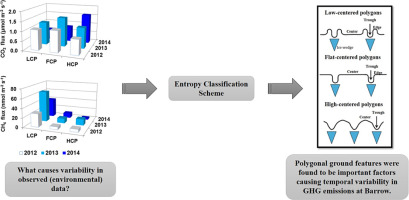Science of the Total Environment ( IF 8.2 ) Pub Date : 2018-08-21 , DOI: 10.1016/j.scitotenv.2018.08.251 Bhavna Arora , Haruko M. Wainwright , Dipankar Dwivedi , Lydia J.S. Vaughn , John B. Curtis , Margaret S. Torn , Baptiste Dafflon , Susan S. Hubbard

|
There is significant spatial and temporal variability associated with greenhouse gas (GHG) fluxes in high-latitude Arctic tundra environments. The objectives of this study are to investigate temporal variability in CO2 and CH4 fluxes at Barrow, AK and to determine the factors causing this variability using a novel entropy-based classification scheme. In particular, we analyzed which geomorphic, soil, vegetation and climatic properties most explained the variability in GHG fluxes (opaque chamber measurements) during the growing season over three successive years. Results indicate that multi-year variability in CO2 fluxes was primarily associated with soil temperature variability as well as vegetation dynamics during the early and late growing season. Temporal variability in CH4 fluxes was primarily associated with changes in vegetation during the growing season and its interactions with primary controls like seasonal thaw. Polygonal ground features, which are common to Arctic regions, also demonstrated significant multi-year variability in GHG fluxes. Our results can be used to prioritize field sampling strategies, with an emphasis on measurements collected at locations and times that explain the most variability in GHG fluxes. For example, we found that sampling primary environmental controls at the centers of high centered polygons in the month of September (when freeze-back period begins) can provide significant constraints on GHG flux variability – a requirement for accurately predicting future changes to GHG fluxes. Overall, entropy results document the impact of changing environmental conditions (e.g., warming, growing season length) on GHG fluxes, thus providing clues concerning the manner in which ecosystem properties may be shifted regionally in a future climate.
中文翻译:

评估北极苔原环境中温室气体(GHG)通量的时间控制:基于熵的方法
在高纬度北极苔原环境中,温室气体(GHG)通量存在明显的时空变化。这项研究的目的是调查在AK,巴罗的CO 2和CH 4通量的时间变化,并使用一种新的基于熵的分类方案来确定导致这种变化的因素。特别是,我们分析了在连续三年的生长季节中,哪种地貌,土壤,植被和气候特性最能解释温室气体通量的变化(不透明的腔室测量值)。结果表明,CO 2通量的多年变化主要与土壤温度变化以及生长初期和后期的植被动态。CH 4通量的时间变化主要与生长季节期间的植被变化及其与主要控制因素(如季节性融化)的相互作用有关。北极地区常见的多边形地面要素也显示出温室气体通量的多年显着变化。我们的结果可用于确定野外采样策略的优先级,重点是在解释温室气体通量变化最大的位置和时间收集的测量结果。例如,我们发现在高中心地区的中心采样了主要的环境控制措施9月(冻结期开始时)的多边形可以显着限制温室气体通量的变化,这是准确预测未来温室气体通量变化的要求。总体而言,熵结果记录了变化的环境条件(例如,变暖,生长季节长度)对温室气体通量的影响,从而提供了有关未来气候中生态系统特性可能在区域内转移的方式的线索。







































 京公网安备 11010802027423号
京公网安备 11010802027423号